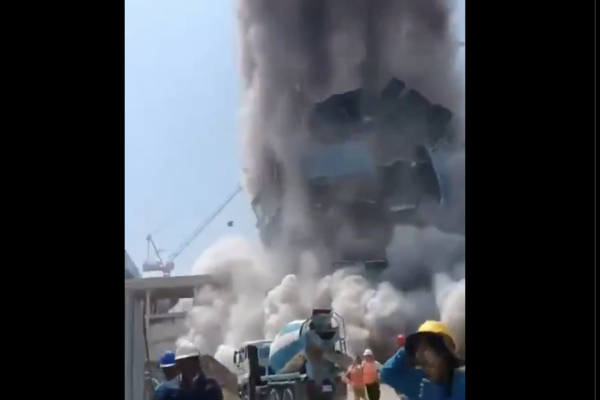On Friday, local time (March 28), a 7.7 magnitude earthquake struck in central Myanmar. Multiple buildings collapsed in Mandalay, the second-largest city in Myanmar. A under-construction skyscraper in Bangkok, the capital of Thailand, also collapsed due to the earthquake. This building was a new office building for the National Audit Office of Thailand, jointly built by China Railway Tenth Bureau Group and another Thai company, with China Railway Tenth Bureau Group responsible for overall implementation.
According to reports from Reuters and Agence France-Presse, Thai officials stated that the earthquake in Myanmar affected Thailand, causing a 30-storey skyscraper in Bangkok to be leveled, leading to the unfortunate deaths of 3 workers, while 81 people are trapped in the rubble waiting to be rescued.
The Thai media outlet Khaosod reported that there were approximately 300-400 workers at the scene when the building collapsed. A preliminary investigation indicated that 67 workers were missing, but the specific casualty numbers are currently unable to be determined, with authorities making full efforts in search and rescue operations. Earlier reports suggested that there were around 50 workers inside the building, with 7 people successfully escaping after the accident, while 43 remain trapped under the debris. The final number of trapped individuals is yet to be confirmed.
Bangkok Mayor Chadchart Sittipunt stated at a press conference that it has been confirmed that 3 people lost their lives due to the earthquake, with authorities receiving 169 reports regarding building damages. Public transportation in Bangkok has been temporarily suspended and is expected to resume operations tomorrow. Local authorities have warned of possible aftershocks.
According to reports by Thailand’s PBS Thai media, Sutthipong Boonnithi, the Deputy Auditor-General and spokesperson for the Thai National Audit Office, announced that due to the impact of the earthquake in Myanmar, the new office building under construction in the Chatuchak district of Bangkok for the Audit Office had completely collapsed during construction. The project’s construction progress had reached 30%.
Citing reports from Fenghuang Net, the new office building was a 30-storey high-rise structure with a total construction budget of 2.136 billion Thai baht (approximately 420 million yuan), which commenced construction in 2020 but was temporarily halted at one point due to the COVID-19 pandemic. The project was undertaken by the joint venture ITD-CREC [Italian Thai Development Public Company Limited and China Railway Tenth Bureau (Thailand) Co., Ltd.], originally scheduled for completion between the fiscal years 2020 and 2026.
Previously, Chinese media reported that in December 2020, China Railway Tenth Bureau and Italian Thai Development Public Company Limited jointly won the bid for the National Audit Office building project in Thailand, with China Railway Tenth Bureau responsible for overall implementation. This project is the tallest and largest single building area project that China Railway Tenth Bureau has undertaken overseas to date.
Following the collapse of the aforementioned building, netizens directly pointed out that this was a “substandard construction project.”
Under the rule of the Chinese Communist Party, “substandard construction projects” have been exported as part of Xi Jinping’s initiative of the “Belt and Road.”
According to reports from CNN and other international media outlets, on November 1, 2024, the roof of the Novi Sad railway station in northern Serbia collapsed, resulting in at least 14 fatalities.
The railway station had just completed a three-year reconstruction project in July 2024, and Serbian Minister of Construction Vesic stated that the railway station project was undertaken by China Railway International Company Ltd. (CRIC) and China Communications Construction Company Ltd. (CCCC).
On June 26, 2017, the collapsed Sigiri Bridge in Kenya, built by China Railway Tenth Bureau, resulted in at least 27 injuries. The Sigiri Bridge is located in the Budalangi area of western Kenya, spanning the Nzoia River, with a cost of approximately 80 million yuan.

